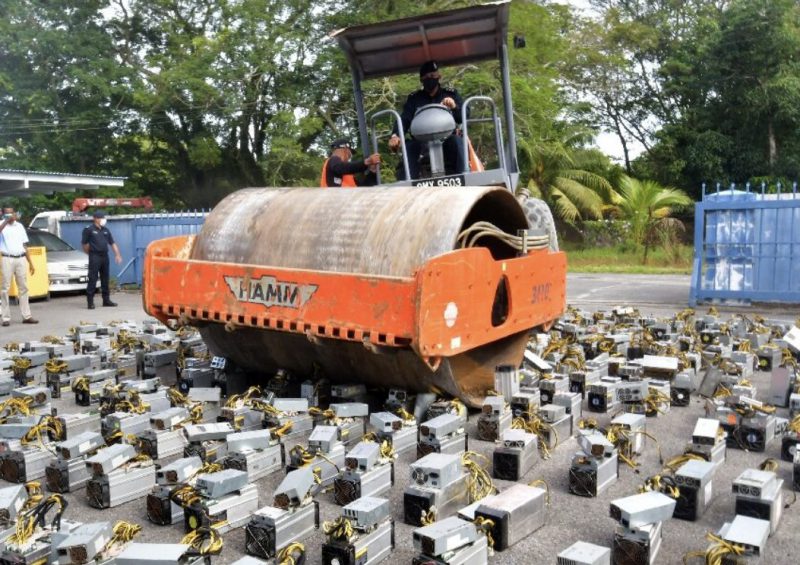Is Crypto Mining Dead? An In-depth Analysis of Ethereum Miners
Mining has always played a crucial role in powering the blockchain networks that underpin these digital assets in cryptocurrency.
However, as the industry evolves, questions arise about the future of crypto mining.
In particular, many are curious about the fate of Ethereum miners. In this article, we will conduct an in-depth analysis of Ethereum mining to answer the question: Is crypto mining dead?
Also read: Bitcoin Mining Targets 8% Global Emissions


The Evolution of Crypto Mining
Crypto mining has come a long way since the early days of Bitcoin.
Initially, mining could be done on regular computers using their Central Processing Units (CPUs).
However, as more people entered the mining industry, the competition increased, and the need for more efficient mining methods became apparent.
This led to the rise of mining with Graphics Processing Units (GPUs), which were more efficient at tackling the complex mathematical problems involved in mining.
The quest for efficiency didn’t stop there. The introduction of Application-Specific Integrated Circuits (ASICs) marked a significant milestone in the evolution of crypto mining.
ASIC miners are specialized devices designed specifically for mining a particular cryptocurrency. They offer unparalleled speed and efficiency, quickly dominating the mining landscape for the cryptocurrencies they were designed for.
Today, the crypto mining industry is a complex ecosystem combining ASIC and GPU mining.
ASIC mining dominates the mining of cryptocurrencies like Bitcoin due to its high efficiency and hash rate. On the other hand, GPU mining remains relevant, especially for mining various altcoins and for miners who value flexibility.
Also read: Kraken Crypto Exchange to Launch Stock Trading
Understanding Ethereum Mining
To understand the future of Ethereum mining, it’s essential to delve into how it works. Ethereum currently uses a proof-of-work (PoW) consensus mechanism, which relies on miners to solve complex mathematical puzzles to validate transactions and add new blocks to the blockchain.
Miners use their computational power to compete against each other, with the first miner to solve the puzzle being rewarded with newly minted Ethereum tokens.
Ethereum mining primarily relies on GPUs (Graphics Processing Units) due to their ability to perform parallel computations efficiently. However, with the recent Ethereum 2.0 upgrade, the network is transitioning from PoW to proof-of-stake (PoS).
This shift means that instead of relying on computational power, Ethereum will rely on validators who hold and stake a certain amount of Ethereum.
The validators will be randomly selected to create new blocks and validate transactions based on the amount of Ethereum they hold and are willing to lock up as collateral.
The Impact of PoW and PoS on Ethereum Miners
The transition from PoW to PoS in Ethereum has significant implications for miners. PoS eliminates the need for miners to solve complex mathematical puzzles, making traditional GPU mining obsolete for Ethereum.
As a result, many Ethereum miners face the challenge of whether to continue mining Ethereum or switch to other cryptocurrencies that still rely on PoW.
The move to PoS has sparked debates within the mining community. Some miners argue that the shift will lead to a more energy-efficient and environmentally friendly network, as PoS requires significantly less energy than PoW.
However, others worry about the potential loss of income for miners who have invested in expensive mining rigs and equipment.


Challenges Faced by Ethereum Miners
Ethereum mining, like any mining activity, comes with its own challenges. One of the primary challenges miners face is the increasing difficulty of mining Ethereum.
As more miners join the network, the competition for block rewards becomes tougher, requiring more computational power and resources to mine successfully.
Another significant challenge is the rising cost of electricity.
Mining Ethereum requires substantial electricity to power the mining rigs and keep them running 24/7. With electricity costs varying significantly across different regions, miners in high-cost areas may struggle to maintain profitability.
The initial investment required to set up a mining operation can also be substantial. Miners need to purchase specialized hardware, such as GPUs or ASICs, which can be expensive.
They must also consider cooling systems costs, maintenance, and dedicated spaces to house the mining rigs.
The State of Ethereum Mining in the United States
Various factors, including electricity costs, regulations, and access to mining hardware, influence Ethereum mining in the United States.
Electricity costs vary significantly across different states, with some offering more favorable rates for miners. States with access to renewable energy sources, such as hydroelectric or solar power, may have a competitive advantage in lower electricity costs.
Regulations also play a role in shaping the mining landscape in the United States. Some states have embraced cryptocurrency mining and blockchain technology, creating a favorable environment for miners.
However, other states have imposed restrictions or regulations that may impact the feasibility of mining operations.
Access to mining hardware is another crucial factor. The demand for mining equipment, especially GPUs and ASICs, has surged recently, leading to shortages and increased prices.
Miners in the United States may face challenges in acquiring the necessary hardware to start or scale their mining operations.
The Future of Ethereum Mining
Given the transition from PoW to PoS in Ethereum, the future of Ethereum mining may seem uncertain.
However, it’s important to note that Ethereum mining is not completely dead.
While traditional GPU mining for Ethereum will become obsolete, there are still opportunities for miners to adapt and find new avenues for mining profitability.
One option for miners is to switch to other cryptocurrencies that still rely on PoW. Numerous altcoins available for mining offer different algorithms and potential profitability.
By diversifying their mining activities, miners can mitigate the risks associated with the transition to PoS.
Another option is to explore alternative mining methods, such as mining with proof-of-capacity (PoC) or proof-of-space (PoS) cryptocurrencies.
These consensus mechanisms rely on storage space rather than computational power, offering a different approach to mining that may be more accessible and profitable for miners.
Ultimately, the future of Ethereum mining will depend on the success of Ethereum 2.0 and the adoption of PoS.
If Ethereum’s transition to PoS proves successful and the network maintains its value and usability, miners may need to adapt their strategies and explore alternative mining opportunities to remain profitable.
Is Crypto Mining Dead?


After analyzing the current state and future prospects of Ethereum mining, we can conclude that crypto mining is not dead.
While the transition to PoS in Ethereum may render traditional GPU mining obsolete, there are still opportunities for miners in other cryptocurrencies and alternative mining methods.
Miners need to stay informed about the latest developments in the crypto-mining industry and adapt their strategies accordingly.
This may involve exploring new cryptocurrencies, optimizing mining operations, or considering alternative sources of income within the crypto ecosystem.
In conclusion, while the landscape of crypto mining is evolving, it is far from dead.
Miners who are willing to adapt and explore new opportunities can still find profitability in the ever-changing world of cryptocurrency mining.
Tips for Ethereum Miners
For Ethereum miners navigating the changing landscape of crypto mining, here are some valuable tips to consider:
- Stay informed: Keep up with the latest news and developments in the crypto mining industry to make informed decisions about your mining activities.
- Diversify your mining portfolio: Explore mining opportunities in other cryptocurrencies that still rely on PoW. This can help mitigate the risks associated with the transition to PoS in Ethereum.
- Optimize your mining operation: Continuously evaluate and optimize your mining operation to maximize efficiency and reduce costs. Consider factors such as electricity consumption, cooling systems, and mining hardware efficiency.
- Consider alternative mining methods: Explore alternative mining methods, such as proof-of-capacity or proof-of-space cryptocurrencies, which may offer different opportunities for profitability.
- Network and collaborate: Join mining communities and forums to network with other miners, share insights, and stay updated on the latest mining trends and opportunities.
- Stay adaptable: Be open to adapting your mining strategies and exploring new opportunities as the crypto mining landscape evolves.
Conclusion
In conclusion, the future of Ethereum mining may be uncertain due to the transition to PoS. However, crypto mining as a whole is far from dead.
While traditional GPU mining for Ethereum will become obsolete, there are still opportunities for miners to adapt and find profitability in other cryptocurrencies and alternative mining methods.
As the crypto mining industry evolves, miners must stay informed, diversify their mining activities, optimize their operations, and explore new opportunities. By embracing the changes and being adaptable, miners can navigate the challenges and continue to find success in the world of crypto mining.
So, is crypto mining dead? The answer is no. While the landscape of crypto mining is constantly evolving, there are still opportunities for miners to find profitability. The key lies in staying informed, adapting to changes, and exploring new avenues for mining.
While traditional GPU mining for Ethereum may no longer be viable, other cryptocurrencies and alternative mining methods remain to consider.
By diversifying their mining activities and staying adaptable, miners can continue to thrive in crypto mining.





